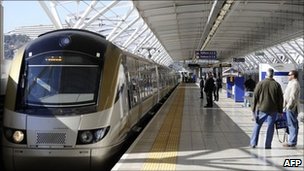EMT
Platinum Member
- Jan 13, 2010
- 14,483
- 15,308

Africa's fastest train has opened its new route to the capital, Pretoria, from Johannesburg in a bid to speed up travel between two of South Africa's major cities. The Gautrain takes less than 30 minutes for the 54km (34 mile) journey. It can take up to two hours to travel this distance by car during rush hour. The Gautrain's inaugural airport route was opened just in time for the 2010 World Cup, when it was used by thousands of football fans. But by reaching Pretoria, it is likely to be used by ordinary South African commuters to beat the traffic on one of South Africa's busiest roads.
Tickets for a single trip between Rosebank and Pretoria cost 46 rand ($6.90; £4.20) - 18 rand more than the price of a minibus taxi but cheaper than the cost of driving.Hundreds of commuters turned up at Johannesburg's Rosebank station as early as 05:30 local time (03:30GMT) for the train's first trip to Pretoria. "I arrived here at 06:30, the bus dropped me right in front of the building here. The train ride was brilliant - everything is well organised [and] on time," one commuter told Talk Radio 702.
Some minor glitches were reported, including technical issues in one of the carriages but engineers have since attended to the problems, Gautrain officials said. The government says it aims to make rail transport the backbone of the public transport system, according to Transport Minister Sbu Ndebele. "Transport infrastructure over the next two years is guaranteed to radically change the way South Africans travel due to a multibillion rand boost by the government," Mr Ndebele said, reports the New Age newspaper.
The train's top speed is 160 km/h (100 mph) - a long way from the world's fastest trains but still far superior to the locomotives chugging along most of the rest of the continent's tracks, which mostly date from the colonial era, says the BBC's Pumza Fihlani in Johannesburg. The Gautrain is expected to reduce the number of cars on the N1 Ben Schoeman motorway which links Pretoria and South Africa's economic hub Johannesburg by 20%. This would mean 25,000 to 30,000 fewer cars on that stretch of road, where traffic is currently increasing by 7% each year. The train operates between 05:30 and 20:30 weekdays, running every 12 minutes during peak times.
Water seepage
Although the project created close to 100,00 indirect and direct jobs it has seen its fair share of controversy. The Gautrain cost 25bn rand ($3.8bn; £2.29bn) to build, more than three times the initial 2005 estimate of 7bn rand. This raised questions about whether it was a worthwhile investment. Critics also argued that it would only benefit the elite. They said the money spent should be used instead to improve the existing transport system, which includes the old Metrorail network, which transports two million people daily, instead of beginning a new one.
The Metrorail trains are mainly used as a link between townships including Soweto and Johannesburg. The last leg of the Gautrain - between Johannesburg's Rosebank and Park Station - could not be opened due to water seepage problems. It will only be ready later in the year, Gautrain said. Last week, officials said the delay was a "precautionary measure to ensure that the highest passenger safety standards are adhered to while engineering works are in progress".
BBC News - South Africa Gautrain opens Johannesburg-Pretoria route